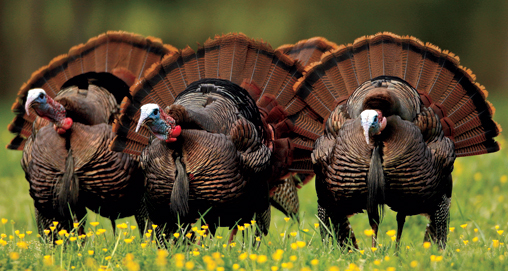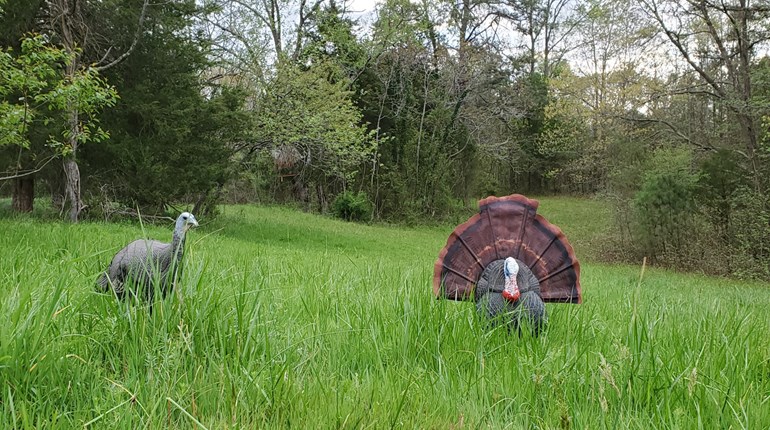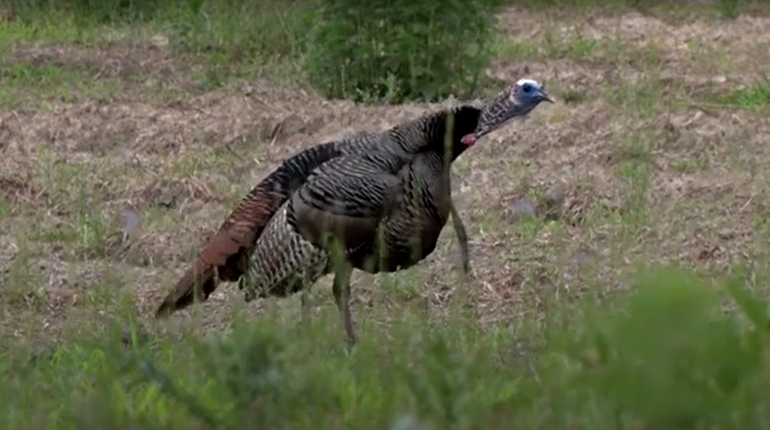
Fraught with uncertainty, the quest for old gobblers often seems to present almost impossible odds. The deck is stacked against the hunter, and the sport is one where the only absolute is that there are no absolutes. Still, the rites of spring seduce us with such irresistible allure, with such mesmerizing magnetism, that somehow turkey hunting’s diverse difficulties are transformed into welcome challenges. After all, as a tribe we revel in misery, and any turkey camp tales of woe are told with at least as much relish as the less frequent accounts of triumphs. Yet deep down every serious turkey hunter, no matter how accustomed he has become to failure or how often he has made a mess of matters through mistakes, wants to improve his odds of taking longbeards with reasonable consistency.
The following 10 tips are offered from that perspective. They provide no surefire formula for success, but maybe, just maybe, these tidbits will infuse moments of magic into your adventures during the time of greening-up, gobbling turkeys and the good earth’s renewal.
1. The Comfort Zone
Under certain conditions it may be possible to call a longbeard to the gun almost anywhere you set up. As a general rule though, you need to set up in a place where a gobbler will be comfortable. It should be a location devoid of impediments—ditches, branches, creeks, thick brush, fallen trees, fences and the like—that can cause a longbeard to hang up. In hilly or mountainous regions, it is better to be above him than below him. Keep in mind that regardless of the terrain, an amorous tom wants to see and be seen. When things happen quickly or when you strike a bird at close range, you don’t have a lot of choice on your setup site. Be sure to position yourself in what might termed the “comfort zone.”
2. Behind-the-Scenes Positioning
One problem with setting up where gobblers feel most comfortable is the matter of exposure. Lordly longbeards want to be where they are easily seen by the ladies, which translates to a distinct preference for strutting in settings such as open woods, fields, or along old logging roads. They enjoy being on a big stage, but the hunter who finds himself in the middle of that setting is vulnerable because he is all too visible. The solution is to set up, even in the most open of areas, where you are in effect back stage or off stage. In other words, find a thicket or tree lap at the edge of a field; be near a bend in an old logging road; or set up 20 or 30 yards below a ridge crest rather than atop it. While it won’t always be possible, the ideal setup is one which will place the gobbler within gun range when you are first able to see him.
3. The Water Equation
Turkeys are never more comfortable at night than when roosted where they can hear their droppings splash. Creeks and rivers provide travel corridors and escape routes. In dry regions water tanks and stock ponds are daily destinations; in the same sort of terrain roost trees are likely to be found only where there is water. Over much of the country, bottomlands along waterways are the first places to show signs of greening up, thus drawing birds to feed. Gobblers love to strut atop the dams of farm ponds and the same is true for open, sandy areas along rivers. Wetlands interspersed with old levees or spots of slightly elevated ground are favorite retreats for turkeys. Hunters need to factor the water equation into how and where they hunt.
4. The Virtues of
Versatile Calling
For reasons known only to turkeys, a call that seems endowed with magic one day will be a dud the next. The simple truth of the matter is that longbeards are capricious critters when it comes to calling (and most everything else). The hunter’s answer to that reality of the wild turkey’s world is actually a fairly simple one: Be able to use a variety of calls with a reasonable degree of proficiency. We all have our tried-and-true favorite, but no matter what our confidence level is in the old reliable box or slate, there are times when it needs to be set aside. The savvy hunter will carry (and be willing to use) at least three of the five basic types of calls—diaphragms, boxes, friction calls (slates, glass calls), suction yelpers and tubes. When your favorite doesn’t work, try something else. Chances are you will eventually find a call that floats a longbeard’s boat. You’ve got to give him what he wants to hear.
5. Locator Call Logic
Far too many turkey hunters limit their use of locator calls and fail to realize that tools of the shock-gobbling trade have a variety of applications. Sure, owl hooting or crow calling at first light are tried-and-true methods for locating gobblers on the roost, yet turkeys are prone to gobble at a sudden loud or sharp noise any time of the day. Over the years I have maintained diary listings of sounds that caused a gobbler to declare dominion to the world. The list now totals well north of a hundred different sounds—and if I could develop and patent a device that imitates a clap of thunder I’d have a winner. That won’t happen, but at least you can be inventive in trying some offbeat locators. I know a fellow who employs a horn while a longtime buddy sometimes emits what can only be described as a scream of agony. At the very least, when things get slow after the peak of morning gobbling, remember that you can locate birds through means other than cutting or loud yelping. Likewise, locators can be a good way of roosting birds at night, and in certain situations using a locator can keep you in touch with a bird while you do some strategic repositioning. The basic message is a simple one: Locators are underused.
6. Strut Zones
Sound woodsmanship is the defining hallmark of a highly skilled turkey hunter. Those with finely honed skills learn to read sign like the Bushmen of southern Africa recognize and follow game trails. A book they read readily and with delight is that dealing with strut zones. Recent strut marks in sufficient quantity that they identify a strut zone are the turkey hunter’s equivalent of being given the inside track to the Holy Grail. The word “zone” rightly implies regular use of the area and, in most cases, is a place where toms strut not only day after day but year after year. Those gathering areas are a hunter’s lodestone, a place he wants to seek and, once found, one where he wants to spend considerable time. Finding them in the course of a three-day hunt in new territory may be part happenstance, but if like most of us you have spots you visit year after year, locating and using strut zones can sometimes put the cherry atop a turkey hunter’s sundae.
7. Track Meets in the Turkey Woods
Whether you call it “closing ground,” “cutting the distance” or “getting close and personal,” it seems that what was once considered standard tactics for turkey hunters gets less attention with each passing year. Admittedly it’s gratifying to call a turkey from what seems like a country mile to within shooting range, and sometimes circumstances such as property lines dictate that is the only option. Generally speaking, though, if you get a distant gobbler to respond you should do two things—and do them in a hurry: Course the direction of the gobble with a compass, then head in the bird’s direction as rapidly and quietly as possible. A good rule of thumb is to make haste to within what you think is 200 yards of the bird’s location and then set up. If you misjudge the distance, you can always close more ground.
By doing this you accomplish several things. The gobbler believes the hen has shown interest in venturing his way. You reduce the likelihood of the responsive bird being sidetracked by a real hen, and you may avoid potential spots where the turkey would have been likely to hang up. There’s always the possible downside of getting too close, but the positives of track meets in the turkey woods far outweigh the potential for occasionally busting a bird.
8. The Sounds of Silence
One of the first lessons my mentor in this wonderful sport taught me was just how important it was to recognize when not to call. His pithy advice was, “Get his attention and lay a heavy dose of silence on him.” It is human nature to call too often and too loudly, and maybe the best way to put this in perspective is to consider the frequency and volume of real turkey talk. Chances are it’s nowhere near what you are throwing out over the woodland air waves. Keep it soft and infrequent. Think more in terms of clucks and purrs than yelps and cutts unless you are actively working a bird whose mood demands aggressive calling. Periodic glances at your watch may help, as will limiting yourself to calling only once every 10 or 15 minutes. The sounds of silence, broken only once in a while, can be seductive to wary old toms.
9. The Turkey Time Zone
While the tip just offered mentions occasional peeks at a watch, that should not be taken as a recommendation to fall into one of turkey hunting’s deadly traps—the time bomb. Ours is a fast-paced world, driven by schedules, deadlines and appointments. Turkey time doesn’t work that way. There’s all day, every day, from fly down to fly up, to go about the business of being a turkey. The astute hunter tries his best to become immersed in the world of his quarry, and that means having patience and persistence. Haste makes waste in the turkey woods. Ramp things down and function on turkey time. It may take some attitude adjustment but you will find it pays dividends not only in hunting success but in the measure of pleasure derived from the overall experience.
10. Afternoon Delight
Not all states allow afternoon hunting. In places where it is permitted, the hunter who ventures afield before dawn, then revels in the peak vocalization time of early morning only to wind it all up before noon makes a mistake. Turkeys may not talk as much—and they may do some lazing in the shade on hot spring days—but they are still there. By setting up near places such as strut zones, dusting areas, travel routes and food plots, the hunter puts himself where birds are likely to be. Some infrequent and soft calling is in order, and it is heartening to know that if you do get a turkey stirred up in the afternoon, chances are greater that you can work him more often than in the early morning. That’s because hens likely have gone to their nests, dispersed or otherwise left the tom lonely. Afternoons can provide real delight, but only if the hunter is afield to experience it. The tried-and-true turkey hunter is one who hunts hard and long, and when possible that means during the afternoon. After all, you can always take a nap while afield, and any old master will tell you that an afternoon gobble has awakened him from such slumber more than once.
This double handful of tips won’t guarantee filled tags and sagging game bags. Turkey hunting is not a sport of guarantees unless you consider the certainty of foul-ups. What they do is improve the odds a bit and offer something of a primer for making you a better hunter. Ponder these points and ask yourself an honest question in connection with each one: “Is this something I do?” If the answer is no, give careful consideration to incorporating the tip into your overall bag of turkey tricks.





































